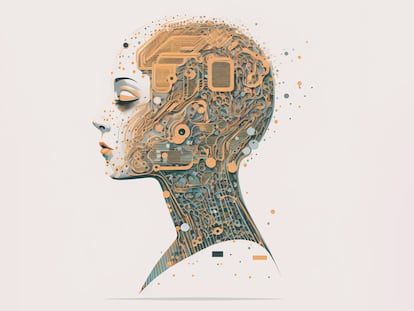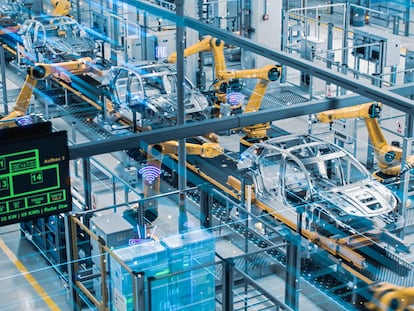The AI black box, the perfect boost for a market at a standstill
The expectations raised by ChatGPT have excited the market, but the pace at which generative AI can be turned into money remains to be seen

The fluency with which ChatGPT writes texts or answers a particular question can be unsettling or exciting, depending on the individual. Its impact in the media in the last four months has transcended the boundaries of technology; few recent developments have so altered economic, labor and social expectations.
For the stock market, and particularly for the technology sector, it has been a shot in the arm. Valuations had soared between excess liquidity and the prospects that the digital trends of the dark months of the pandemic would continue over time. Interest rates were a severe corrective factor, but business plans did not help either. Before artificial intelligence threatened the jobs of the future, technology companies were already destroying jobs of the present.
It has not taken long for the market to embrace the new narrative, with the usual enthusiasm. In four sessions, the seven major technology companies, including Nvidia, increased their stock market value by $454 billion. They have increased their aggregate capitalization by 43% so far this year. Just as the advanced artificial intelligence chatbot gives answers for everything (right or wrong, for almost everything), ChatGPT is itself an answer for clueless investors: when in doubt, buy technology.
Nvidia’s rise has its own explanation, as stated by ChatGPT itself. The company “has been involved in the development of artificial intelligence and machine learning technologies, including the supply of specialized hardware, such as graphics processing units (GPUs), which are used to train and run machine learning models. These technologies are essential for the creation and deployment of language models such as ChatGPT.”
It is, therefore, like the tool salesman who thrives in the middle of a gold rush. To what extent is another matter. The company is trading at 37 times its annual sales. In the terms used by the CEO of Sun Microsystems during the technology bubble of 2000, if the company does not buy materials, does not pay its employees, does not replace obsolete machinery or research, and does not pay taxes, in 37 years paying 100% of its income as a dividend, the investor would recover his money. The PER has exceeded that 200 times.
That is not to say it is a bad investment; all of the big seven tech companies went through times when the accounts were tight. Not when they were already worth a billion dollars, though. History also has numerous examples of crazes for a technology that were misguided, overzealous or simply premature. The speed of recent events may have overlooked the fact that Facebook changed its name to Meta just a year and a half ago, was an unmistakable sign of the social network’s very strong commitment to the metaverse. Sun Microsystems, which was worth 200 billion in 2001, was bought by Oracle for just 7 billion nine years later.
Contrary to the metaverse or cryptocurrencies (two technologies that offer a solution to problems yet to be defined), neural networks, the deep learning technique used by generative artificial intelligence systems, solve problems that have yet to arise. Months ago they allowed scientists to find a pattern that could predict the structure of proteins. This week a paraplegic patient was able to move his legs through an artificial connection, after a deep learning system was able to interpret and process signals sent by the brain.
We do not know how neural networks collect raw data, compare it with real results and automatically adjust the importance of each variable in the final result. ChatGPT has learned how to write texts and, if given the task of writing a letter, would do so after seeing how it ends with the words “Yours” and then “sincerely” in millions of examples. But there is no human explaining why that is so; the program deduces it by comparison with reality — in a way that is similar to what the brain does (another pattern-finding machine).
This mechanism therefore has two basic needs that justify inverstors’ excitement: data and processing capacity. If Nvidia is worth a billion, it is because of its H100 processor, designed specifically for artificial intelligence systems and launched just a few months ago. It is the demand for this processor that has led the company to raise its revenue forecast for the quarter 50% higher than expected, because anyone who wants to jump on the AI bandwagon needs an H100. The second necessary ingredient is data, and that (plus their own investments in AI, of course) explains the rise of Google, Apple and Meta.
According to Société Générale, artificial intelligence explains the entire 8.8% rise in the S&P 500 this year. Without this clamour for AI, the index would drop 2%. Bank of America, for its part, speaks of a “baby bubble,” recalling that previous episodes were formed with cheap money and burst with rate hikes.
Artificial intelligence is a black box in itself, which is also why its future impact is unknown. At the moment, ChatGPT’s combination of power and ease of use promises an explosion of applications, from writing documents and computer code to applications in biomedicine, industry and chemistry. The question remains as to how generative artificial intelligence will respond in less controlled environments, where human intervention (or even the intervention of other artificial intelligences) changes the terrain and the rules of the game on the hoof. Contexts where the patterns of the past do not apply. In any case, investors now have a perfect excuse to dream of multi-digit returns once again.
Sign up for our weekly newsletter to get more English-language news coverage from EL PAÍS USA Edition
Tu suscripción se está usando en otro dispositivo
¿Quieres añadir otro usuario a tu suscripción?
Si continúas leyendo en este dispositivo, no se podrá leer en el otro.
FlechaTu suscripción se está usando en otro dispositivo y solo puedes acceder a EL PAÍS desde un dispositivo a la vez.
Si quieres compartir tu cuenta, cambia tu suscripción a la modalidad Premium, así podrás añadir otro usuario. Cada uno accederá con su propia cuenta de email, lo que os permitirá personalizar vuestra experiencia en EL PAÍS.
¿Tienes una suscripción de empresa? Accede aquí para contratar más cuentas.
En el caso de no saber quién está usando tu cuenta, te recomendamos cambiar tu contraseña aquí.
Si decides continuar compartiendo tu cuenta, este mensaje se mostrará en tu dispositivo y en el de la otra persona que está usando tu cuenta de forma indefinida, afectando a tu experiencia de lectura. Puedes consultar aquí los términos y condiciones de la suscripción digital.
More information
Archived In
Últimas noticias
Rowan Atkinson tops Netflix at 70: ‘He’s as funny as ever’
Israeli recognition of Somaliland stirs up the Gulf
Tiger Woods turns 50: Will he continue playing on the PGA Tour or take a back seat?
The surreal journey of James Nnaji, the Barcelona youth player selected in the NBA Draft who ended up in the NCAA
Most viewed
- Oona Chaplin: ‘I told James Cameron that I was living in a treehouse and starting a permaculture project with a friend’
- Reinhard Genzel, Nobel laureate in physics: ‘One-minute videos will never give you the truth’
- Sinaloa Cartel war is taking its toll on Los Chapitos
- Why the price of coffee has skyrocketed: from Brazilian plantations to specialty coffee houses
- Chevy Chase, the beloved comedian who was a monster off camera: ‘Not everyone hated him, just the people who’ve worked with him’











































